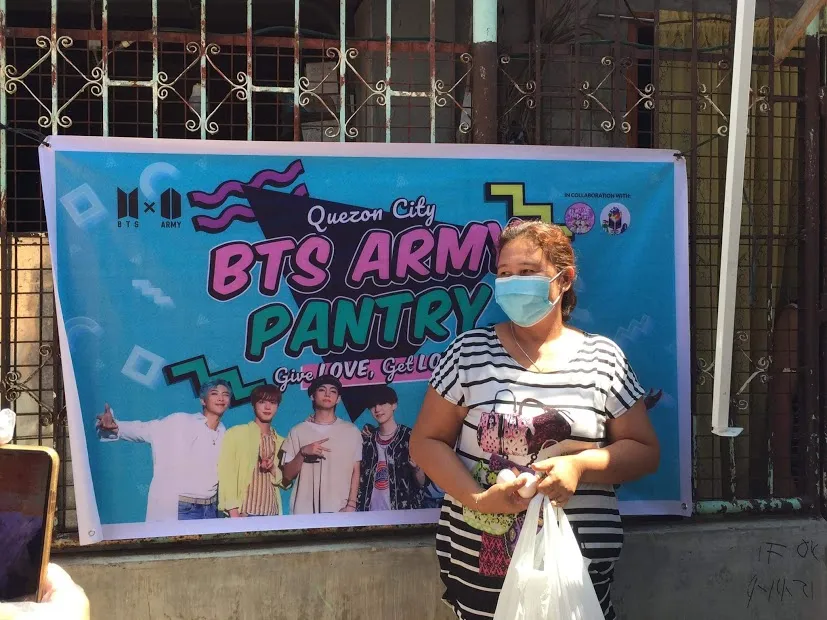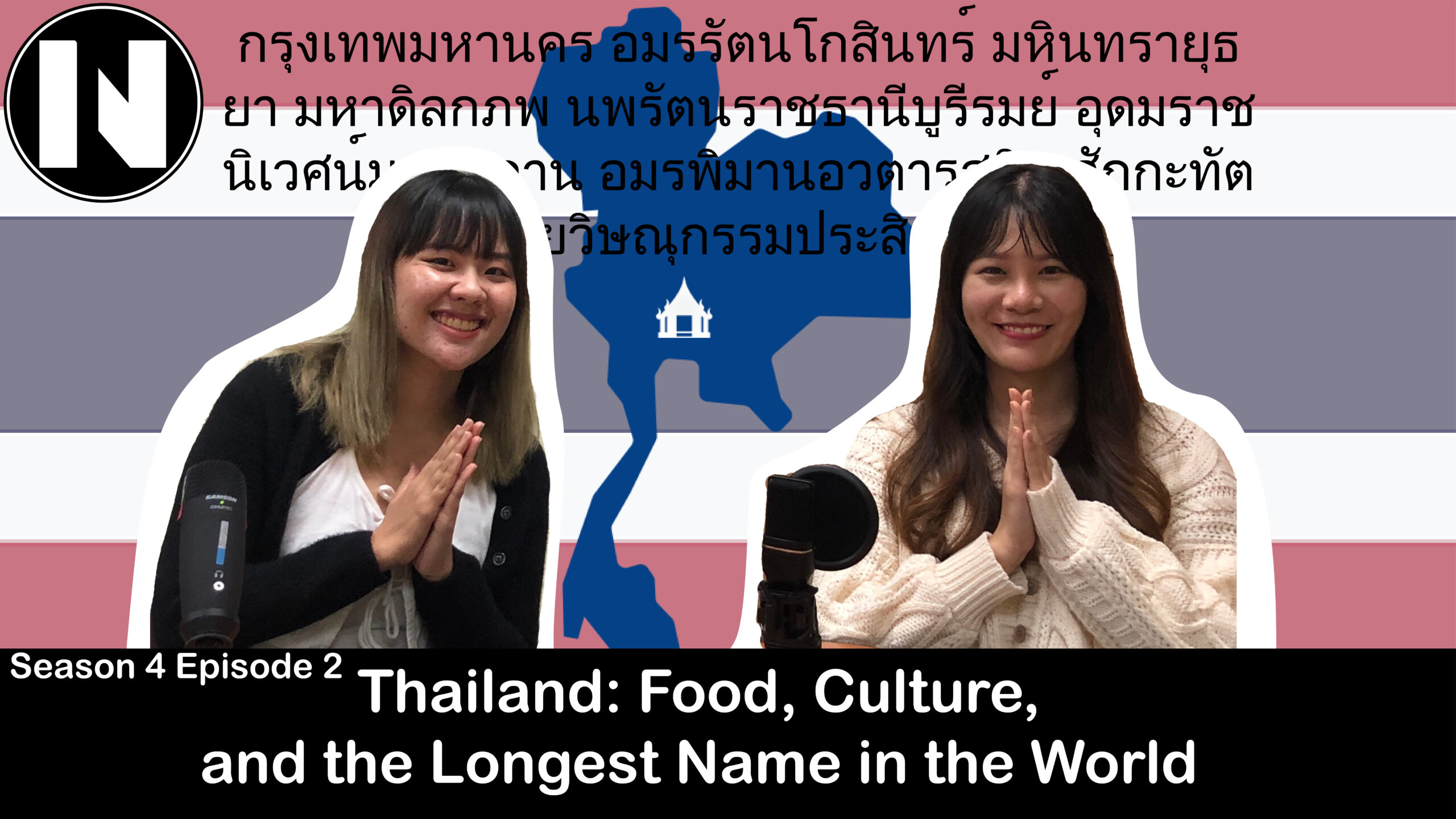How it started
In a small subdivision in Cavite province, Philippines, 23-year-old Bie Rosales is known as the one who “gives away free rice.”
Amid a pandemic-induced lockdown in April 2021, Rosales caught the attention of her neighbors with a poster of K-pop stars BTS. The sign announced that they were giving away free bags of rice, courtesy of ARMY, fans of the group.

Source: ARMY Cavite Fanbase.
“There was news of a tricycle driver in our neighborhood ending his life because he could no longer deal with the multiple problems caused by the lockdowns,” Rosales says. “People were starving because of the pandemic,” she recounts.
It was this dire local landscape that pushed her, along with around 6,000 others to put up their own community pantries. The concept, first introduced in March 2021 by 26-year-old entrepreneur Ana Patricia Non in Metro Manila, was guided by a simple tenet: Magbigay ayon sa kakayahan, kumuha batay sa pangangailangan (Give whatever you can, take only what you need).
Non rolled out a small bamboo cart on Maginhawa Street, filling it with extra produce for neighbors to take for free. Overnight, a growing line of residents came to take a small portion of what was available, a bag of rice, a pack of noodles, a can of sardines–but they also left what they could share.
Symbol of hope
The Maginhawa Community Pantry quickly went viral and became a symbol of hope during a tumultuous time. Locally known as “community quarantines,” strict lockdowns were imposed on each village in the Philippines since March 2020. Many did not have the means to feed themselves, as public transportation halted and businesses shut down.
To workers who relied on their daily salaries, dying from the virus seemed like the least of their worries.
The idea behind the community pantry spread quickly during a time of economic crisis, ironically proving that kindness was more contagious than the coronavirus.
The K-pop network
K-pop fans, known for their active presence on social media, took the cue from Non and worked to expand the idea, launching one for each of their favorite groups.

Source: Parkers Republic.
Adorned with merchandise of their idols, Hallyu-themed community pantries started popping up all over the nation, with more fans joining hands to provide food supplies and hygiene kits to their communities.
Aside from ARMYs, fans of other groups like GOT7 and Philippine darling Sandara Park of 2NE1 were able to put up their own K-pop-themed community pantries.
“[The] K-pop community here in the Philippines is big. [We] know that through our platform, we could help a lot of people,” a representative of All About GOT7 Philippines said in an interview with local outlet Inquirer.net.
Jenny, a fan of beloved Philippine idol and 2NE1 member Sandara Park first put up a small community pantry in her area because a lot of her neighbors lost their jobs due to the pandemic.
“After sharing [about our community pantry] on Twitter, some of my co-Dara fans, local and international, donated as well,” Jenny says. With the help of Blackjacks (2NE1 fans) and their donations, Jenny was able to sustain the community pantry for three weeks, feeding a lot of her displaced neighbors due to the pandemic.
These pantries were solely sustained through donations, and somehow, food never ran out. It was the spirit of solidarity that prevailed as the government wasn’t able to provide its people their immediate needs.
“We were inspired by other K-pop fans and Ana Patricia Non to hold our community pantry. We were able to show that we weren’t only obsessed with our idols, but we are also helping our community in our own little way,” Jenny says.
International call to action
Meanwhile, Rosales is a fan of BTS, and the founder of ARMY Cavite Fanbase (ACF), one of the many fan clubs in the Philippines. What started out with a couple sacks of rice evolved into 17 branches of a yearlong community pantry project, one of many that would help Filipinos survive amid the hardships brought upon by the coronavirus.
Rosales and her team at ACF gathered quickly to plan for different stations all over the Philippines. ACF, with its 23,000 Twitter followers and 53,000 Facebook likes, started posting about its community pantries, quickly gaining traction with the help of its ARMY network. Fanbases from the United States, Canada, Pakistan, Brazil, Malaysia and Europe started signal boosting their posts, with donations in US dollars coming into their Paypal account.
Rosales recounts getting help from international fanbases such as One In An ARMY (235,000 Twitter followers), an account dedicated to volunteerism and helping communities under BTS’ name.
“We initially had a budget of P10,000 ($169),” Rosales says. “But we were surprised when donations kept coming in to sustain the pantries. We had a lot of ARMYs messaging us to volunteer to hold their own versions inspired by ACF,” she adds.
The ACF community pantry sprouted to different provinces and cities in the Philippines, thanks to a wide network of fans dedicated to the band. ACF also collaborated with other fanbases to put up more stations, giving them funds to start pantries at different locations.
Donations from ARMYs in Denmark, South Korea and the United States initially helped fund the community pantries, with ACF in charge of gathering supplies. To ensure transparency, ACF even provided complete documentation and updates about the funds they received, posting photos of grocery hauls daily.
Mutual connections
Organizing and mobilizing are part of any fandom’s DNA, from celebrating new music with streaming projects or launching various forms of events for an idol’s birthday. K-pop fandoms are known for being tech-savvy, using their internet influence to campaign for good initiatives that would reflect on their idols.
“I wanted to show that fans of BTS don’t only gush about their looks, but we actually are inspired by the kindness and message of BTS. We want to do good for our community and help our fellow Filipinos,” Rosales says.
“Through BTS, through their music, we were able to connect with more people who wanted to help like us,” she adds.
At their community pantry, Rosales played BTS songs nonstop, singing along with ARMYs who came from Manila to drop off donations. Her family wore BTS-inspired shirts while welcoming visitors who came to get shares of canned goods, vegetables, and other necessities.

Source: ARMY Cavite Fanbase.
“ARMYs would travel all the way to our province just to drop off goods because they wanted to help Filipinos,” she says. When the ARMY community pantry landed in the news for being K-pop-inspired, companies even donated dairy products and hygiene kits to the ARMY pantries.
“When some parents came by the pantry and recognized BTS, they even asked us for posters or photos, because they said their kids were fans, too,” Rosales says.
Aside from being able to get necessary supplies, these types of gimmicks from K-pop fans were able to restore dignity to many Filipinos who struggled during a desolate period in the country.
On the surface, photos of beautiful idols may seem useless to a public struggling to make ends meet. But the air of optimism and teamwork brought about by K-pop fans, along with their genuine desire to help their community showed how organization and mobilization produced tangible results. This chain reaction helped ease the hearts of many hopeless Filipinos during a desolate time.
‘From the masses, for the masses’
When the Philippine government failed to provide adequate aid to its constituents, these communities rose to the challenge with mutual aid, helping each get by during a time of scarcity.
One ACF post about the community pantry states: “During this pandemic, we can only trust ourselves. Masa para sa masa! (From the masses, for the masses).”
“An ARMY found our pantry and even messaged us asking if she could get bags of rice for her family. She was from another city and had to walk all the way to where we were because she was sure she could get help from us,” Jess Sitjar, another ACF organizer says. “They found us because of BTS,” she adds.
It is this bayanihan spirit, or collective action, that rose out of necessity, that continues to be upheld by many K-pop fandoms in the country. Being a fan is an experience best shared, and the Filipino Hallyu community is an example of volunteerism at its best.

Source: ARMY Cavite Fanbase.
Volunteerism inspired by idols
In the Philippines, where Hallyu has been ubiquitous since the 2010s, volunteerism and mutual aid have resulted in social welfare programs spearheaded by fandoms.
When the lockdowns were lifted in late December, ACF held a special community pantry for kids. An inspiration for this was a quote from BTS member Jimin, where he said that kids were specially having a hard time during the pandemic.
“Kids don’t have a lot of options right now to the things they want to do. I imagine a lot of kids see this as something that’s being forced upon them by adults, so I hope the grown-ups will properly explain the situation to the kids so they can help each other too, to end the pandemic,” BTS Jimin said in a magazine interview.
Filipino fan Asta also decided to put up a community pantry in the name of rookie boy group Treasure, saying that the group were advocates for kindness as well. “Treasure are advocates as well and encourages their fans to help make a difference,” she tweeted.
Long-term influences
“We didn’t want the pantries to be a one-time thing,” Rosales says. “Since our pantries landed in the news, a lot of parents have approached me, asking me to teach their kids how to help, since they were also fans of BTS.”
K-pop has introduced another channel for sociocivic movements to rise in the country. Having a mutual point of connection through a fandom creates a vast interconnected network that makes it easy to mobilize quickly. It imbibes the idea of collective action, and during the pandemic, even introduced a certain kind of selflessness.
Even after the lockdowns, Rosales didn’t take down the BTS poster that asked people to come and knock for free rice. It became a mainstay in their community, with many in their village coming to their door to ask for help.
“Every time people ask me why we do this, I always say that it’s because of BTS,” she says.
This kind of cooperation and sense of collective action wasn’t built in a day. The radical teamwork behind fandoms often goes unnoticed or is overshadowed by the stereotype of obsessive young fangirls. When fans are equated to hysteria and addiction, it is easy to overlook the social impact and tangible results they produce, despite helping many communities.
These K-pop pantries, full of color and music, were not only providers of food, but of hope as well. Despite being a temporary solution, the revolutionary kindness that community pantries brought during a time of immense economic crisis will forever be remembered in history as a successful showcase of community solidarity.
“A lot of people underestimate us because we’re K-pop fans because they don’t understand what we do,” Rosales adds. “For them, we’re just ditzy or toxic fans. With the community pantry, we were able to show how diverse, helpful, and generous a lot of ARMYs are, while also spreading BTS’ message of love and kindness.”
- In Medias Res: How the press makes and breaks global affairs - October 31, 2023
- Fact checkers on the digital front lines: The war against disinformation on social media - August 3, 2023
- Trash talking: The imperialism of the global waste trade - May 14, 2023







1 Comment
Jenny
2 years agoAmazing articles, thank you for sharing!
Comments are closed.